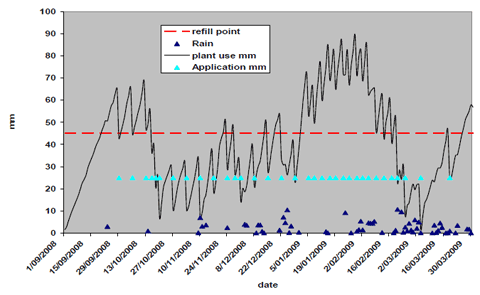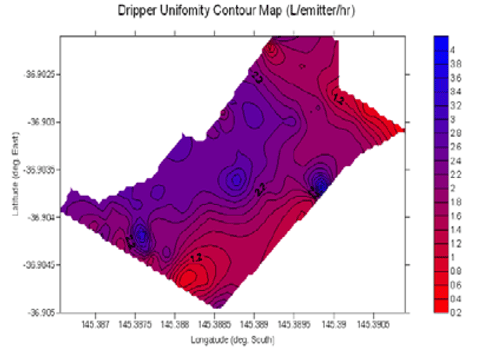IrriGate newsletter, Issue 4 spring 2010
Download the PDF version of this document: Irrigate Newsletter - Issue 4 - Spring 2010 (PDF 225 KB)
To view the information PDF requires the use of a PDF reader. This can be installed for free from the Adobe website (external link).
Sustainable Irrigated Landscapes - North East - Mid and Upper Goulburn Broken
 |  |
| North East Dryland Catchment | Goulburn Broken Dryland Catchment (excluding the Shepparton Irrigation Region) |
Welcome to IrriGate Issue 4 - spring 2010. Thank you to those who contacted me on address corrections, and please check your envelope details and contact me with any changes or if you wish to unsubscribe. SIL team member, John Hunter, is now working on other DPI projects and we thank John for his assistance in the past twelve months in the SIL team.
Editor - Wendy Paglia
Inside this issue
Monitoring your irrigation over the season | SIL Incentives | Irrigation System Performance Checks | DPI NE/GB Sustainable Irrigation Team - Dryland
Monitoring your irrigation over the season
Irrigators know the importance of applying the right amount of water at the right time in order to maximise crop production, but how do you really know if it is right. In the coming irrigation season, DPI will be conducting a program to help irrigators record when and how irrigation water is applied and compare this to theoretical crop water-use.
Throughout the irrigation season, irrigators will be able to gauge if they are applying too much or too little water for the conditions at the time. This is particularly important for spray irrigation where insufficient irrigation applications can lead to compounding moisture stress.
In the example shown in Figure 1 (shown below), irrigation occurred too late and was too little at the start of the season. It was not until mid-October when moisture levels were sufficient to avoid plant stress, through to January, where the irrigation was unable to keep up with plant use. The crop has spent 40 per cent of its time under moisture stress (above the dotted red line). However, it would have only taken one more irrigation of 25 mm at the start of the year to reduce this
figure to 10 per cent.

Figure 1: An example of irrigation and rainfall compared to plant use. When plant use is above the red line, plants are stressed.
Participants in this program will gain a better understanding of irrigation scheduling and avoiding the risk of lost production by not applying enough water or the added cost of wasting water and pumping by applying too much. If irrigators are interested in monitoring their irrigation practise over the coming season please contact Dennis Watson at DPI Rutherglen on (02) 6030 4567.
SIL Incentives 2010/2011
Rebates are available to landholders for the purchase of:
- Irrigation farm plans for improved irrigation management.
- Soil moisture monitoring equipment and similar tools. Help is also available for equipment selection installation and data interpretation.
Irrigation System Performance Checks
The irrigation team are available to help check your system to determine
if it is operating at the industry standard.
These system checks can include measuring the following:
- The average application rate.
- Distribution uniformity (evenness of the water being applied).
- Pressure and flow variations at different locations across the paddock.
These checks will help determine if your system is applying the amount of water it is designed to, and if it is applying this evenly across the paddock

DPI NE/GB Sustainable Irrigation Team - Dryland
| Dennis Watson Irrigation specialist DPI Rutherglen Centre (02) 6030 4567 0429 304 567 dennis.watson@dpi.vic.gov.au |  Dennis Watson |
| Ian Gamble Catchment Management Officer DPI Wangaratta Centre (03) 5723 8671 0437 362 620 ian.gamble@dpi.vic.gov.au |  Ian Gamble |
| Wendy Paglia Project Support Officer DPI Ovens Centre (03) 5731 1206 wendy.paglia@dpi.vic.gov.au |  Wendy Paglia |
If you would like to receive this information/publication in an accessible format (such as large print or audio) please call the Customer Service Centre on: 136 186, TTY: 1800 122 969, or email customer.service@dpi.vic.gov.au
Published by the Department of Primary Industries,
Sustainable Irrigated Landscapes, April 2010,
© The State of Victoria, 2010
This publication is copyright. No part may be reproduced by any process except in accordance with the provisions of the Copyright Act 1968.
Authorised by the Victorian Government, 1 Spring Street, Melbourne 3000
ISSN :1837-4077
Disclaimer:
This publication may be of assistance to you but the State of Victoria and its employees do not guarantee that the publication is without flaw of any kind or is wholly appropriate for your particular purposes and therefore disclaims all liability for any error, loss or other consequence which may arise from you relying on any information in this publication.
For more information about DPI go to www.dpi.vic.gov.au or call the Customer Call Centre on 136 186.


